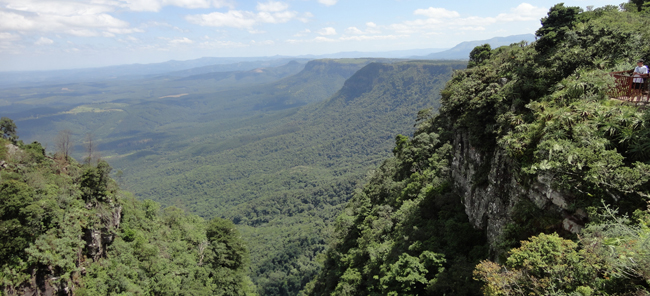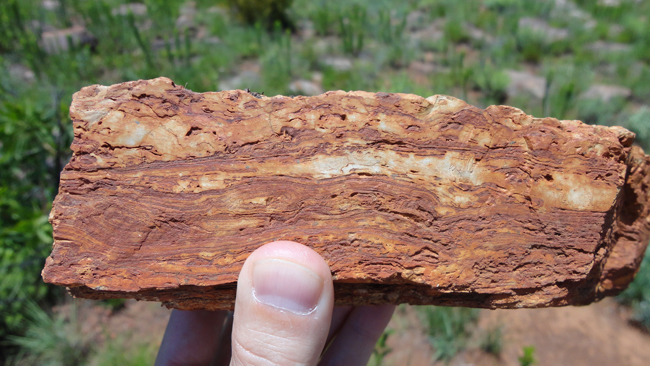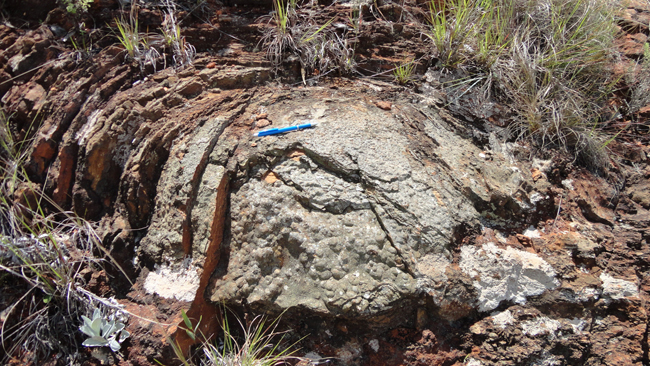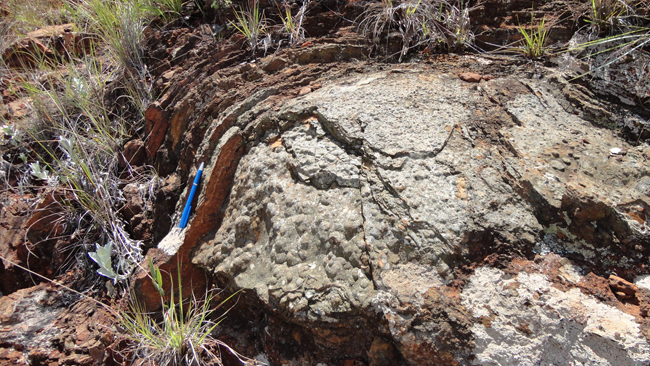After our safari, Lily and I were taken up onto the Great Escarpment in northern South Africa. The escarpment is supported by sedimentary strata of the Transvaal Supergroup that overlie the Archean basement rock of the Kaapvaal Craton. The Transvaal strata are Paleoproterozoic in age, somewhere between 2.5 and 2.0 billion years old. They are a mix of siliciclastic sediment and carbonates. Here’s the view from an overlook dubbed “God’s Window,” with perspective towards the south along the east-facing escarpment, with Wolkberg Group quartzites gently dipping off to the west and providing the “lip” of the plateau:

While quartzites (metamorphosed quartz sandstones) are all well and good, I’ll focus on the carbonates in this post. I was excited to be in this area, because I remembered reading an old post on Chris Rowan’s blog Highly Allochthonous about giant stromatolites in the area. So I was on the lookout for stromatolites.
One of the paving stones at the overlook featured an array of small (cm-diameter) stromatolites, but the obscene placement of this gorgeous array led to severe degradation from the sandy soles of oblivious tourists:

Then I found a little hand sample that bore crinkly algal laminations in cross-section:

Nice… but not really in the same league as the multi-meter stromatolites of my yearning. We drove by some nice meter-wide examples in a roadcut on the highway, but our driver and guide refused to stop, citing the risk of car-jacking in that particular stretch of road. “Sorry, mate,” he told me, “but I don’t want to be a statistic.”
I frowned and sulked. I wanted a damn stromatolite, and I wanted it in situ!
Thankfully, I spotted one on the drive up to the Three Rondawels, and my driver decreed it safe enough to stop the Kombi. Here it is: a respectable, if not monstrous, stromatolite, with a blue pen for scale:


This beastie is a domed layer in the Malmani Dolomite (should be “Dolostone,” grumble grumble). The carbonate sediment was trapped by formerly-photosynthetic cyanobacterial slime that covered the ocean floor more than two billion years ago, and it added layers upward and outward over time, like a botryoidal mineral’s growth. All the time they were living and growing, these ancient microbes were generating waste oxygen, which they thoughtlessly dumped into the atmosphere. At first, this excess free oxygen bonded with reactive elements like iron (producing banded iron formations), but after a while, it began to build up to higher and higher levels in the atmosphere. A billion and a half years later, it had built up to the point that a whole new suite of organisms could take over. These novel critters were multicellular and heterotrophic, and they thrived in the miasma of cyanobacterial waste gas. These mutants were destined to take over the world. They were animals, and they never would have had a chance without the accumulated waste of billions of stromatolites over billions of years.
By reading the excellent book Geological Journeys by Norman and Whitfield, I found out two weeks after my visit to the escarpment that I missed the giant stromatolites by only about ten kilometers. For the reference of any future geotourists, the really big guys (from Chris’s post) are located at the top of Sudwala Pass.

They should have called that book Georneys 🙂
No, that’s the title for the book that you’re going to write!
Thanks for the photos (and the attempt at photos – “car-jacking” Wow!) of the stromatolites, Callan. Proterozoic rocks have always fascinated me and conjure up a strange alien world, like something out of a Chesley Bonestell painting.
They just had a tech talk at the University of Kansas about the Microbially Induced Sedimentary Structures (MISS) by Nora Noffke from Old Dominion University. She was using examples from South Africa & they were much older rocks (~3ga). Ofcourse these weren’t exactly stromatolites, but were still interesting: http://sci.odu.edu/oceanography/news/seminars/fall2011/noffke.shtml
Yeah, I know Nora personally through the Geological Society of Washington, and can attest to the inherent interest of her unique line of research. Thanks for sharing the link.